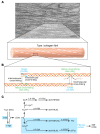The fibrotic tumor stroma
- PMID: 29293090
- PMCID: PMC5749516
- DOI: 10.1172/JCI93554
The fibrotic tumor stroma
Abstract
Intratumoral fibrosis results from the deposition of a cross-linked collagen matrix by cancer-associated fibroblasts (CAFs). This type of fibrosis has been shown to exert mechanical forces and create a biochemical milieu that, together, shape intratumoral immunity and influence tumor cell metastatic behavior. In this Review, we present recent evidence that CAFs and tumor cells are regulated by provisional matrix molecules, that metastasis results from a change in the type of stromal collagen cross-link, and that fibrosis and inflammation perpetuate each other through proteolytic and chemotactic mediators released into the tumor stroma. We also discuss aspects of the emerging biology that have potential therapeutic value.
Conflict of interest statement
Figures



References
Publication types
MeSH terms
Grants and funding
LinkOut - more resources
Full Text Sources
Other Literature Sources

